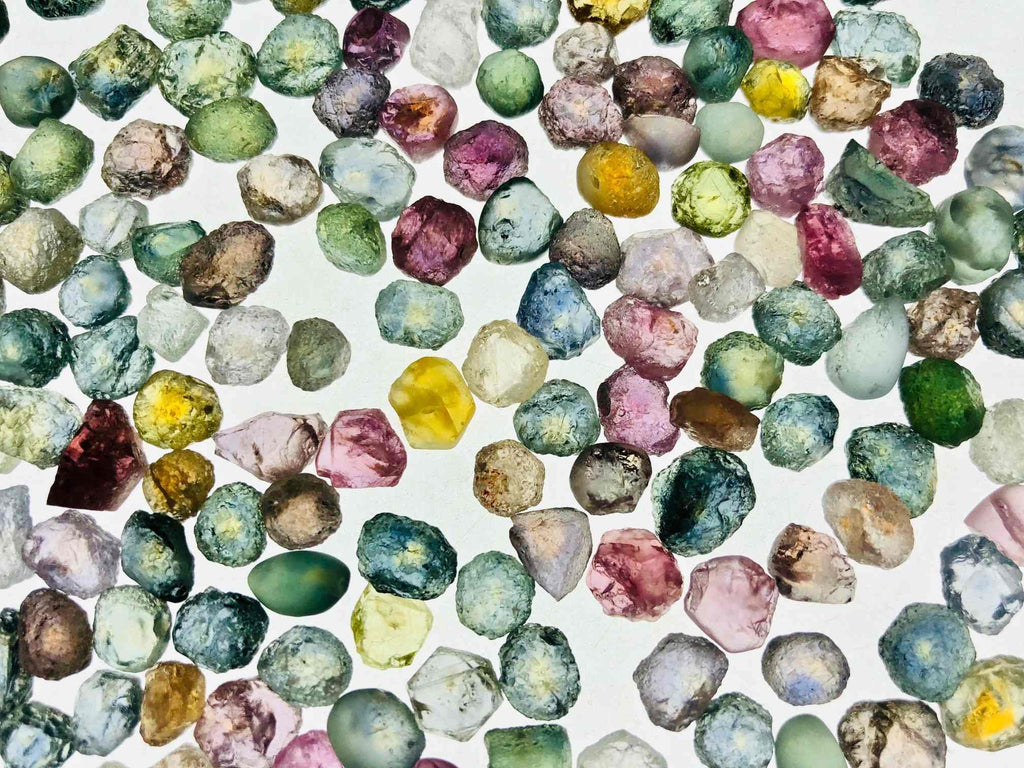Montana Sapphire Mine Tour of a Lifetime
I had the most amazing opportunity to visit the Potentate Sapphire Mine in Montana for a two-day tour. It was like a dream come true! I enjoyed this visit so much, and fell so hard for Montana Sapphires, that I styled my logo using the colors of the rough sapphires I touched while there.

The Potentate Mine is the largest sapphire mine in the Western Hemisphere. It lies about 1.5 hours from Missoula in the Sapphire Mountain Range. The mine encompasses 3000 acres and is an alluvial mine. Mining operations began in this location at least 100 years ago. At the time, the sapphires were sent to Switzerland for use in the movements of Swiss watches.
At Potentate, most of the mining is done by pulling dirt and rocks from the earth’s surface, not by deep digs or via a vein. Montana’s Department of Environmental Quality requires that the mine re-grade the land and re-seed grass after mining.

The mine processes between 10-20 kilos of ore per day, and at around 4:30pm 6 days a week, the miners pack up the day’s haul of ore and transport it to the sorting facility, which is attached to the office. The days haul includes a mixture of sand, rocks, steel shot, fine gold dust, along with sapphire, garnet, and quartz rough.
I watched the sorting machines in action! They consisted of a giant sifter which used a powerful magnet and water pressure in order to clean the sand from the sapphire rough, as well as sort it into general sizes. We were instructed to leave any cellphones and credit cards in the office while watching this machine in action, since the magnet was powerful enough to erase and/or interfere with both (hence no photos from that process).

After the machine sorting happens (which was run by two miners), human hands take over and remove sapphire rough from the rocks using tweezers and Tupperware. Soon, they will buy equipment to automate this process, and I am glad we did this mine tour before that because we enjoyed the tedious process of sorting sapphire from rocks very much (giant smiles the whole time because, well…. sapphires).
Two human sorters work one tray at a time, sitting opposite each other. They start with a pile of rocks in the middle of the tray, and methodically bring the rocks toward them while removing the sapphire rough and placing it one by one into the Tupperware as they go. When each feels as if they have gotten every last sapphire out, they rotate the tray 90 degrees and sort through their partner’s rough, seeing if they can find any leftovers (making it into a bit of a competitive game).

This was such a satisfying activity that they had to basically pull me from my tray in order to embark on a 4-wheel driving tour of the mine. The tour drove us through cattle pasture (this land is multi-purpose), and old mining shacks. The shacks were from the bygone days of early mining. This site had been mined from 1905-1930, and during that time, miners extracted 60 tons of sapphire from these hills.
We saw several sites which had been tested for sapphires or actually mined and re-seeded. Later, we remarked that when we originally heard that we would be visiting an open-pit mine, we expected deep excavations. All were surprised to learn that the ore is taken from the surface of the land, not from river beds, veins in the earth, or large pits. The land appeared to be in good shape, and made for excellent grazing for the neighbor’s cattle.

The area where the Potentate Mine sits is an environmentally sensitive site, because it encompasses the Rock Creek. Rock Creek is an internationally renowned fly fishing habitat for trout, drawing tourists from near and far for fly fishing adventures. Potentate cannot perform any operation which will muddy the waters of the Rock Creek.
After our 4-Wheel drive tour of the mine property, we went back to the sorting area near the office to learn how the ore is sorted. The Potentate Mine processes between 10-20 cubic yards each hour. The ore goes through several elaborate machines outside which go something like this:
- Ore is processed through a machine which removes material larger than one inch in diameter. According to the mine operator, sapphire does not usually exist in chunks larger than one inch.
- All material which is smaller than one inch in diameter goes through a machine which vibrates it through and further sorts the rocks into a medium and small sizes.
- Then, the rocks are intermixed with steel shot in the next machine, which sorts material by weight. The steel shot, fine gold dust, and sapphire are heavier than the other rock, so the other rock travels down a conveyer belt while the sapphire, fine gold dust, and steel shot (along with many stray rocks) are left over.
- The sapphire/rock/steel shot/gold mixture is washed down another conveyer belt to remove as much sand as possible.
- The sand is deposited in one pile, which looks like a giant sand dune, and the water used in this reclamation process goes directly into a series of 4 settling ponds. The first pond is totally murky, the second pond slightly less so, the third pond has more clarity, and the fourth pond, to the naked eye, appears to be clean water, which is pumped back into the process all over again. They are able to recycle and reuse between 80-90% of the water, losing 10-20% in this process, mainly due to evaporation.

Fun Facts from our Mine Tour:
- Every single test performed on the Potentate land yielded sapphires.
- All sapphire rough is washed in hydrofluoric acid to remove a fine layer of grime from the surface.
- At Potentate Mine, inclusions in sapphire are referred to as “silk”.
- The “silk” is usually removed by heat-treating the sapphires in a special process. The Potentate Mine outsources this heat treating to a company in Philipsburg.
- Most Montana Sapphire is faceted overseas.
- Sapphires which have more than one color in them are called “parti color”. I like to think of them as "party color" though!
- The sapphires are not embedded in the rocks. They are loose among the other rocks, therefore easy to extract with tweezers and Tupperware.
- They found a 60 carat sapphire recently, which is heading to the Smithsonian Institute.


